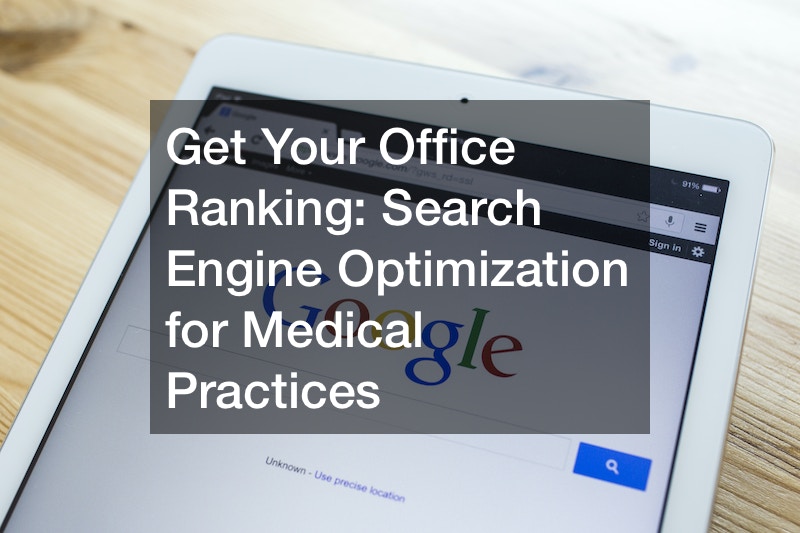
If you’re like most medical practitioners looking to establish a strong online presence, you’ve probably come across the term ‘search engine optimization for medical practices.’ Creating a solid search engine optimization strategy for your medical practices is important but can seem daunting. Fear not! In this article, you’ll learn everything you need to improve the SEO rankings for your medical practice. So let’s dive in!

Importance of SEO for Medical Practices and Services
SEO involves optimizing websites and web content to rank on page one of search engine results pages(SERPs) when searching for relevant keywords. It’s useful for every type of business, including your medical practice. Most of your potential clients or patients are sitting somewhere on their phones or laptops surfing the web.
When they feel like they’re falling sick, they turn to the internet to look up their symptoms. The medical landscape is rapidly changing, and so should you. You’ll find some medical practitioners conducting consultations online; it’s pretty interesting. Whether you’re an optometrist, run an inpatient rehab center, or offer any other medical services, you may be wondering, ”How can I leverage SEO?’.
1. Define your goals
What do you want to achieve with your search engine optimization for medical practices? Do you want to increase brand awareness, get more email subscribers, generate leads, or drive sales? Be specific in your goals so you can track your progress. Note that everything in an SEO marketing campaign is measurable (from the beginning to the end). It would be best to use this by forming a digital marketing plan with specific milestones and targets.
Typical goals include raising brand awareness. For instance, your goal as a vascular interventional radiologist may be to increase Facebook followers from 10k to, say, 500k. Also, your medical practice website should get mentions from high-traffic websites, appear on page one of Google searches, and increase YouTube video views. Increasing organic traffic. This includes targeting high-ranking keywords to your new content, updating existing content on your website, and running email outreach campaigns to get links that point to your website.
2. Create a Website Architecture
Define your medical practice’s core service areas on your website. Having a broad understanding of the industry’s core areas helps you implement better search engine optimization for medical practices. Before keyword research, check the areas that relate most to your practice specialty or offering. Identifying your main specialty areas makes your website architecture navigation and planning keyword research easier.
Identifying your key services helps break down your website’s architecture. An example is a medical care provider offering chiropractic care services. The practice’s core offerings could include relief from neck or back pain, improved blood pressure levels, enhanced spinal alignment and joint Range of Motion (ROM), corrected posture, and joint erosion prevention, including non-invasive pregnancy therapy. Another detailed example of possible medical practice core service areas is occupation therapy, which may include self-care skills, memory problems, personal care and dressing, mobility and falls, seating and wheelchairs, and the workplace.

3. Relevant Keyword Research
One of the things you’ll come across when searching ”how can I use SEO for my medical practice” is the importance of using keywords. Simply put, these are what your patients type in the search bar when looking for a hospital and any other medical service. Here, you want to get in the mind of your target audience.
Knowing the core business areas will help you quickly understand relevant keywords related to your practice’s core service areas. You can develop a content plan focusing on the core services from this information. This helps your search engine optimization for medical practices. by attracting leads, in this case, patients.
Start by gathering a list of relevant keywords for each core area of your medical practice’s website. If you have multiple sub-areas of focus, say you are a womens physician, perform keyword research for each medical offering to find the most popular keyphrases. Optometrists can use the same approach. If the core offering area has multiple focus areas, break them down and perform keyword research for each sub-area of your practice.
There are a few ways to understand your users’ needs and search intent. You can look at your website’s analytics to see what keywords users search for on your medical provider site. You can also use keyword research tools like SEMrush, Google AdWords, Keyword Planner, and Moz Keyword Explorer to see what kinds of keywords websites like yours are using for them to be visible.
4. Choose your Topic Ideas Based On Keyword Clustering And Analysis
Grouping similar keywords into clusters is crucial for search engine optimization for medical practices. The keyword clustering process helps you identify the most relevant high-traffic keywords for your medical website and optimize your website content for search engines. This technique can improve your site’s search engine rankings and attract more traffic and leads to your site.
For instance, a vascular interventional radiologist medical practitioner may have a keyword like ‘angioplasty,’ ‘angiography,’ and ‘tumor ablation.’ You could use these keywords to identify the most relevant terms to your practice’s target audience and use them accordingly to optimize your website. That’s how keyword clustering works!
When picking the primary keyword for each group of clusters, there are several factors that you need to take into consideration. These include keyword competitiveness, your competitors’ number of quality backlinks they have, underserved areas in their intent, knowledge gaps, including your topical authority. By scrutinizing these factors, a medical provider like a family doctor can determine the most beneficial keywords for their SEO content strategy.
5. Run a Competitor Analysis
This is one of the most critical aspects of digital marketing. By understanding what your competitors are doing, you can adapt your SEO marketing strategy to be more effective. There are numerous ways to carry out competitor analysis. One way is to monitor digital marketing activity; for example, search for other local orthopedic doctor websites offering similar services in your location and see what they are doing that works well.
Another way is to use digital marketing tools such as Google AdWords or BuzzSumo to track their activity and see what keywords they are targeting. Either way, competitor analysis is essential to digital marketing and should be prioritized. By understanding your competitors, you can stay one step ahead by ensuring your search engine optimization (SEO) strategy is current.
6. Open a Google My Business Profile
PatientPop research shows that 61% of patients search for information about doctors or medical providers online regularly. Most searchers prefer Google as their search engine of choice. Google My Business(GMB) has high visibility and authority in local search rankings.
Creating a Google My Business profile introduces potential clients (patients) in your locale, making it a great addition to your search engine optimization for medical practices efforts. Besides drawing attention to your website, optimizing your profile as a general dentist practitioner can drive website traffic and book new patients. According to BrightLocal, 5% of views on Google My Business listing lead to a website click, direct request, or call.
7. Know Your Audience
Who are you trying to reach with your digital marketing? Take time to research your target market and understand their needs. This will help you create content that resonates with them. It would help if you considered the following when it comes to your audience identification: Specific areas or countries that your potential clients/customers reside, their age bracket, gender, interests, occupation, marital status, and educational background
It’s important to note that the exact details would depend on your medical line of practice. Analyzing the available data is a great way to craft your buyer personas. This could be digging into your Google Analytics reports, search console, Facebook audience insights, and Google Ads reports.

8. Identify your channels.
Not all digital marketing channels are created equal. It would help to choose the proper channels for your business and goals. Once you know your target audience and what you want to achieve, you can determine which digital marketing channels will be most effective for medical practice. Some popular digital marketing channels include search engine optimization for medical services (SEO), Pay-per-click (PPC) advertising, social media marketing (Facebook, Twitter, LinkedIn, etc.), content marketing (blogs, infographics, ebooks, etc.), email marketing, online PR.
By understanding which channels are most effective for reaching your target audience, you can create a digital marketing plan that maximizes your chances of success. There are several ways to identify your channels, including using analytical tools like Google Analytics or social media listening platforms. You can also ask your target audience how they prefer to consume digital content.
9. Create Quality Content
Now that you know who you’re trying to reach and how to reach them, it’s time to start creating content. This could be in the form of blog posts, ebooks, infographics, or anything that is shareable and informative. Ensure that your content is original and that there is no duplication to avoid being penalized by Google. You can use tools like Copyscape to check for plagiarism.
Remember, creating engaging, informational, and valuable content is key to helping you achieve your goals. So, ensure everything you put out is well-written, informative, and engaging. Don’t forget to promote it. You can do this through social media, email marketing, paid advertising, guest posting, or any other appropriate channels.

10. Analyze Your Results
After pushing your content for a while, it’s important to analyze the results to see what is working and what isn’t. This will help you adjust your strategy moving forward. Analyzing your results is crucial to any digital marketing plan, whether you’re just starting or looking to improve your existing efforts.
So, how do you go about analyzing your results? Here are a few essential tips:
First, set clear goals and objectives. Before analyzing your results, you must know what you’re trying to achieve. What are your goals and dreams? Are you looking to increase brand awareness? Drive more traffic to your website using search engine optimization for medical practices or generate more leads or sales. Once you have a clear understanding of your goals, you can start measuring your results against them.
Use the right tools and metrics. There are several digital marketing tools and platforms, each with metrics and reporting features. It’s essential to use the right tools to get accurate data. Some standard digital marketing tools include Google Analytics, Social Media Analytics, and Email Marketing platforms.
Collect and analyze your data. Now, it’s time to start collecting and analyzing your data. This data will help you understand how well your search engine optimization (SEO) Strategy is performing and where there are opportunities for improvement. There are many ways to collect data, including web analytics tracking, surveys, customer feedback, and social media listening.
Search engine optimization for medical practices involves making data-driven decisions. This means using your data to identify areas of opportunity and make changes where necessary to improve your results. For example, consider changing your approach if your social media campaigns perform better than you intended. Or, if you notice that specific keywords are driving a lot of traffic to your website, you may want to focus more on optimizing them.
Lastly, test and experiment; Data is only valuable if you use it to make improvements. The only way to know if a change will improve your search engine optimization for medical services strategy is to test it out. Start by making small changes and testing them over time. For example, you could experiment with different social media strategies or use a new tool to see if it improves your results.
If you see a positive impact, you can start implementing the change on a larger scale. Remember that what works today may not work tomorrow is also important. By regularly analyzing your results and experimenting with new strategies, you can ensure the effectiveness of your search engine optimization for medical practices efforts.
Note that search engine optimization for medical practices is an ongoing process. It’s important to continually monitor your website and ensure you use the most effective techniques. Suppose you fail to keep up with the latest trends. In that case, your website will decline in the search engine results.
Search engine optimization for medical practices can be complex. Still, you can set your practice up for success by crafting a well-thought-out strategy or hiring a digital marketing agency to do it for you. You want to establish yourself as an authority in the medical field, particularly on the web.
The one whose blogs patients turn to when they have symptoms they can’t explain. Whether you’re an eye doctor or offer occupational therapy, think of your online presence as your practice’s reception area. It’s one of the first things people will interact with, so ensure it draws people in.



